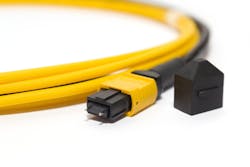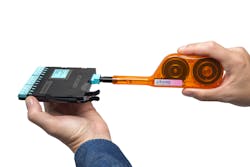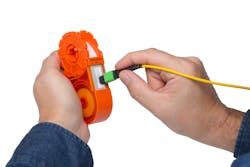Cleanliness: The key to polarity- and gender-change success
By Jay Tourigny, MicroCare
Although multifiber push-on (MPO) connectors have been around for more than 20 years, some fiber technicians still do not encounter them very often. Single-fiber LC and SC connectors are still more common and more often used. However, that is changing quickly. As the demand for more and faster data increases across the globe, MPO connectors are emerging as the connector of choice.Because of their higher fiber capacity, MPO connectors offer many benefits for high-speed networks. They are ideal for terminating high-density cables in high-concentration environments, for instance inside telecommunications companies or hyperscale data centers. They simplify high-speed, high-mass installations and interconnects. A single MPO connector can replace multiple single-fiber LC or SC connectors yet provide more than 10 times their fiber density. This saves on network installation time. It also uses less space inside tight telecom rooms and small cable ducts.
MPO challenges
But while MPO connectors have benefits over LC and SC connectors, they can be challenging for installers. Here’s why.
· Polarity: Because MPO connectors are multifiber, they have no polarity. Polarity refers to the way the light signal travels through the fiber endface and how it matches its partnering endface. Different network applications need different polarity types. But, no one polarity type is better than another. There are three types of fiber polarity. Type A, or the straight-through method, is where the signal located at position 1 (P1) on one end also arrives at P1 on the other end. Type B, or the inverted method, is where signal located at P1 on one end arrives at P12 at the other end. The third, Type C, or twisted pair method, is where the signal located at P1 on one end arrives at P2 on the opposing end, P2 arrives at P1, and so on. When polarity isn’t maintained between the endfaces, the transmit signal (Tx) at one end doesn’t match the corresponding receiver (Rx) at the other end. This results in signal misdirection, damaged equipment and network downtime.
· Gender: Unlike LC or SC single-fiber connectors, which are all male, MPO connectors are male (with alignment pins) or female (with corresponding guiding holes). This is the male/female configuration or basically pins/no pins. Typically, the MPO interfaces on active equipment are male (with pins) and MPO patch cords are female (without pins). To ensure the signal alignment between two endfaces, installers must use a male-to-female configuration.
Sometimes it is necessary to change the polarity or the gender of MPO connectors in the field. For instance, a fiber harness is mistakenly made with the wrong gender or polarity and must change to complete an installation. Fortunately, it is possible to change the polarity from A to B, or change the gender from male to female, and vice versa. This flexibility is vital because it allows installers to continue with the installation instead of stopping and waiting for a new cable order or delivery.
Some manufacturers make tools that flip the polarity of the MPO connector. It switches the connector from “key up” to “key down,” or from polarity Type A to polarity Type B. They also make pin exchanger tools to change MPO connector genders. The alignment pins insert or remove to make a male or female connector as needed. The tools are easy to use and provide good results. But the risk of possible endface contamination during these procedures is high. So it is a must that the endfaces are properly cleaned before continuing with the installation.
Control the contamination
Dirty connectors are the single most common reason for fiber-optic network failures. This is because the interconnect is the only point in the network where the core of the glass fiber carrying the optical signal comes in contact with contamination from the external environment.
MPO connectors are more susceptible to contamination than LC and SC connectors. The larger surface area along with the higher quantity of fiber end surfaces means it is easier for MPO endfaces to get contaminated. Also, each of the many fibers attached to an MPO connector extends a small distance from the ferrule. This means fiber ends touch when the MPO connectors mate.Then there is the high number of moving parts, all of which can cause wear debris. Wear debris dust generates by the contact friction when MPO connectors mate. For example, from the connector slider, the retention clips, and also from the guide pins. The same strong contact force that holds mated pair termini together, also grinds dust particles into the ferrule surfaces. This results in scratched, pitted or scarred endfaces.
So it is crucial that the MPO mated endface surfaces are clean. Otherwise the contamination could cause signal loss. That means unreliable performance or even a complete system shutdown.
When cleaning MPO endfaces, always remember to use the three-step process of inspect, clean, inspect. Inspect each MPO endface with an inspection scope to determine the extent and type of contamination. Then clean each endface using tools and fluids engineered for cleaning fiber optics. After cleaning, and before mating, reinspect the endface to ensure it is clean. Repeat this cleaning and inspection process until the endface is clean.
Use the right cleaning tools
There are tools designed for cleaning MPO connectors. One option is to use a “click-to-clean” tool that removes dust, particulate and oil contamination with a single click. The smooth push-action, with light contact force, reduces the risk of endface damage. Look for a tool that cleans both male and female connectors. Ideally, the cleaning devices will not be “keyed,” allowing the installer to flip the device orientation to use it facing up or down. This “keyless” feature is helpful when working in confined spaces, near floors or ceilings, or when the connector is obstructed.
A second option is to use a cassette-style tool. These are compact cleaning tools that fit into toolboxes and are ideal for use in the field, but typically can clean only the male end of any fiber connector. They feature a cleaning ribbon to trap dust and absorb contaminant. Look for one with a translucent plastic housing. It shows the installer how much cleaning ribbon remains, avoiding the surprise of running out and associated delays.
Wet/dry cleaning
Wiping an MPO endface with a dry tool often generates a significant static charge. That in turn attracts dust that is difficult to dissipate. Repeated cleaning attempts only compound the problem. Instead, use the wet/dry cleaning method recommended by both IPC (Institute of Printed Circuits) and iNEMI (interNational Electronics Manufacturing Initiative). It reduces static and helps meet the IPC-8497-1 fiber optic cleaning standard. Wet/dry cleaning increases the humidity on the MPO endface. That dissipates the surface static, allowing easier cleaning.During the wet/dry cleaning process, the installer dampens the cleaning tool with a static-dissipative cleaning fluid before cleaning. This removes the contamination and minimizes the static charge in one step. Also, wet/dry cleaning works especially well on heavily soiled endfaces.
Choose the right fluid
Many installers still use isopropyl alcohol (IPA) for cleaning MPO connectors. But there are better alternatives to alcohol for endface cleaning. Installers should choose a high-purity cleaning fluid that cleans the MPO endface without leaving residue behind. It should also come in a hermetically sealed container. A sealed container ensures the cleaning fluid is never contaminated. It also won’t spill if it tips over in a tool kit or while in use. If preshipping fluids and tools to job sites, choose a fiber cleaning fluid that ships non-hazardous and non-regulated. This saves on shipping costs. In some instances, these cleaning fluids also come in travel-sized containers. So installers still meet the TSA 3-ounce-or-less rule if they take it with them in a carry-on bag when flying to a work site.
MPO connectors are becoming increasingly necessary to meet the fiber and cable density needed to support next-generation architectures. Although essential, MPO connectors are vulnerable to contamination. With a larger surface area than single-fiber connectors, and the capacity to contain many fibers across a single connector ferrule, the risk of contaminants finding their way to the fiber increases. But installers can mitigate this with proper endface cleaning using the right tools and fluids.
When choosing fiber-optic cleaning fluids, tools and methods, installers should seek the help of an experienced supplier—one that specializes in MPO fiber-optic cleaning tools and methods. They can recommend specific products engineered for MPO use, and designed to effectively clean these increasingly popular connectors.
Jay Tourigny is senior vice president at MicroCare, which offers precision cleaning, lubricating and debinding solutions. He has been in the industry for more than 30 years and holds several U.S. patents for cleaning-related products.



